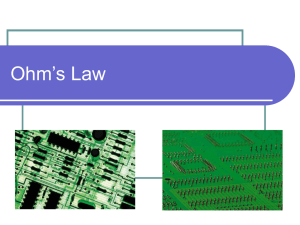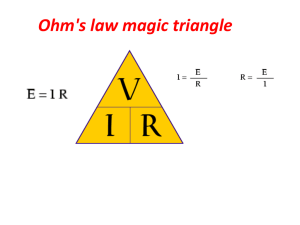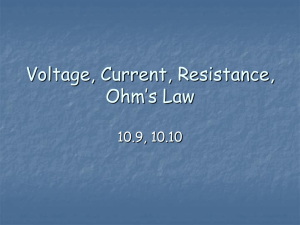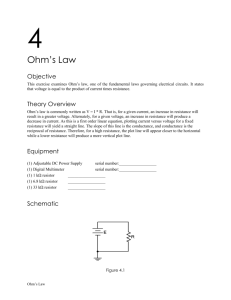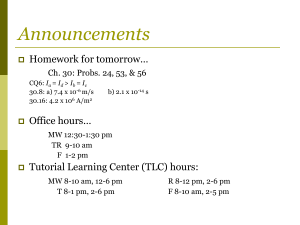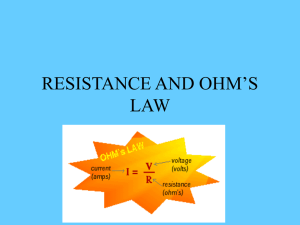Ohm's Law & Lines: Algebra & Telecommunications Course Material
advertisement
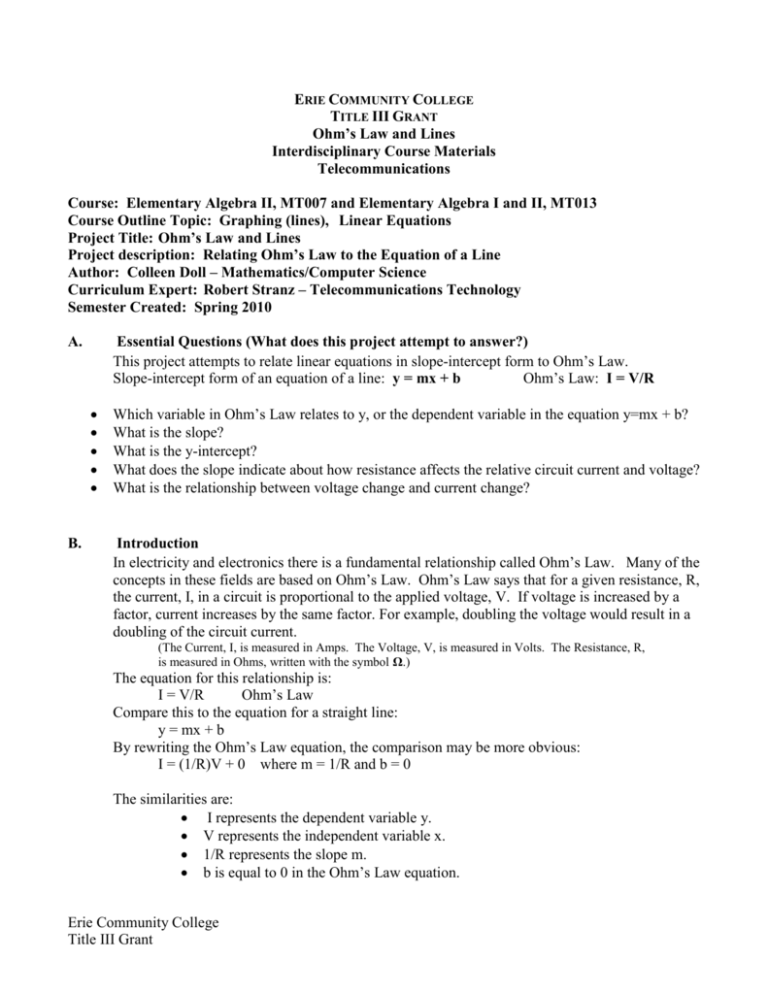
ERIE COMMUNITY COLLEGE TITLE III GRANT Ohm’s Law and Lines Interdisciplinary Course Materials Telecommunications Course: Elementary Algebra II, MT007 and Elementary Algebra I and II, MT013 Course Outline Topic: Graphing (lines), Linear Equations Project Title: Ohm’s Law and Lines Project description: Relating Ohm’s Law to the Equation of a Line Author: Colleen Doll – Mathematics/Computer Science Curriculum Expert: Robert Stranz – Telecommunications Technology Semester Created: Spring 2010 A. Essential Questions (What does this project attempt to answer?) This project attempts to relate linear equations in slope-intercept form to Ohm’s Law. Slope-intercept form of an equation of a line: y = mx + b Ohm’s Law: I = V/R B. Which variable in Ohm’s Law relates to y, or the dependent variable in the equation y=mx + b? What is the slope? What is the y-intercept? What does the slope indicate about how resistance affects the relative circuit current and voltage? What is the relationship between voltage change and current change? Introduction In electricity and electronics there is a fundamental relationship called Ohm’s Law. Many of the concepts in these fields are based on Ohm’s Law. Ohm’s Law says that for a given resistance, R, the current, I, in a circuit is proportional to the applied voltage, V. If voltage is increased by a factor, current increases by the same factor. For example, doubling the voltage would result in a doubling of the circuit current. (The Current, I, is measured in Amps. The Voltage, V, is measured in Volts. The Resistance, R, is measured in Ohms, written with the symbol Ω.) The equation for this relationship is: I = V/R Ohm’s Law Compare this to the equation for a straight line: y = mx + b By rewriting the Ohm’s Law equation, the comparison may be more obvious: I = (1/R)V + 0 where m = 1/R and b = 0 The similarities are: I represents the dependent variable y. V represents the independent variable x. 1/R represents the slope m. b is equal to 0 in the Ohm’s Law equation. Erie Community College Title III Grant C. Basic Directions Read and understand A, Essential questions and B, Introduction Complete question #1 a-k and question #2 a-i. Use the attached worksheet to enter your work. Write neatly Show all your work Label units Put your name on your paper D. Things to Learn Before Starting the Project Solving linear equations The Cartesian coordinate system Graphing linear equations Slope-intercept form of an equation of a line E. The Project Assignment 1. A circuit has a 10 Ohm resistor and a 20 volt source. a. b. c. d. e. f. g. h. i. j. k. Use Ohm’s Law, I = V/R, to determine the current. What would be the current, in Amps, if the voltage were doubled? Describe, in English, how this voltage change affected the current. Given the same circuit described in 1, calculate the current if the voltage is reduced by half. Describe, in English, how this voltage change affected the current. Given the same circuit described in 1, calculate the voltage if the current is 5Amps. If the current is 6 Amps, what would be the voltage? For the 1 Amp increase in current, the voltage increased by how many volts? Using Ohm’s Law, I = V/R or (1/R)V. Write a linear equation that relates current, I, in amps, to voltage, V, in volts, for this circuit. (R = 10 Ω) From the equation, determine the slope of this line. m = From the equation, determine what the y-intercept would be. Erie Community College Title III Grant 2. The figure below depicts a simple circuit. Let’s choose a resistor value of 2 Ohms. (R = 2 Ω). a. Using Ohm’s Law, I = V/R or (1/R)V. Write a linear equation that relates current, I, in amps, to voltage, V, in volts, for this circuit. (R = 2 Ω) Enter this equation into the title of the graph on your worksheet. b. From the equation, determine the slope of this line. c. From the equation, determine the y-intercept. d. Evaluate the current, I, in amps, for voltage V = 0, 2, 4, & 6 volts. Plot the points, (V, I), and draw the line on the graph on the worksheet. e. Based on your graph, what is the y-intercept? f. Calculate the slope by selecting two points on the graph, and using the definition of slope, . In this application, the current, I, corresponds to the dependent variable y, and the Voltage, V, corresponds to the independent variable x. g. Fill in the blank with an integer: For every 1 Amp change in current, I, the voltage, V, changes by ___ volts. h. Fill in the blank with a fraction: I is numerically _______ as large as V i. Fill in the blank with a word: If the voltage triples the current will ______________ . F. Student Resources (websites, books, technology, etc.) G. Textbook and notes. Supplemental document: Graphing the Equation for Ohm’s Law.docx Faculty Resources (teacher notes, websites, books, technology, etc.) Worksheet: Lines worksheet.docx Supplemental document: Graphing the Equation for Ohm’s Law.docx Answer key: Lines key.docx H. Grading Rubric 20 parts at 5 points each totals 100 points. Erie Community College Title III Grant

